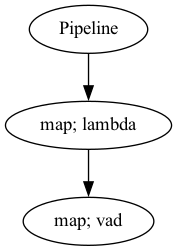Realtime VAD
Contents
Realtime VAD#
Let say you want to cut your realtime recording audio by using VAD, malaya-speech able to do that.
This tutorial is available as an IPython notebook at malaya-speech/example/realtime-vad.
This module is language independent, so it save to use on different languages. Pretrained models trained on multilanguages.
This is an application of malaya-speech Pipeline, read more about malaya-speech Pipeline at malaya-speech/example/pipeline.
[9]:
import malaya_speech
from malaya_speech import Pipeline
from malaya_speech.utils.astype import float_to_int
Load VAD model#
We are going to use WebRTC VAD model, read more about VAD at https://malaya-speech.readthedocs.io/en/latest/load-vad.html
[6]:
vad_model = malaya_speech.vad.webrtc()
[7]:
p_vad = Pipeline()
pipeline = (
p_vad.map(lambda x: float_to_int(x, divide_max_abs=False))
.map(vad_model)
)
p_vad.visualize()
[7]:

Starting malaya-speech 1.4.0, streaming always returned a float32 array between -1 and +1 values.
Streaming interface#
def stream(
vad_model=None,
asr_model=None,
classification_model=None,
sample_rate: int = 16000,
segment_length: int = 2560,
num_padding_frames: int = 20,
ratio: float = 0.75,
min_length: float = 0.1,
max_length: float = 10.0,
realtime_print: bool = True,
**kwargs,
):
"""
Stream an audio using pyaudio library.
Parameters
----------
vad_model: object, optional (default=None)
vad model / pipeline.
asr_model: object, optional (default=None)
ASR model / pipeline, will transcribe each subsamples realtime.
classification_model: object, optional (default=None)
classification pipeline, will classify each subsamples realtime.
device: None, optional (default=None)
`device` parameter for pyaudio, check available devices from `sounddevice.query_devices()`.
sample_rate: int, optional (default = 16000)
output sample rate.
segment_length: int, optional (default=2560)
usually derived from asr_model.segment_length * asr_model.hop_length,
size of audio chunks, actual size in term of second is `segment_length` / `sample_rate`.
ratio: float, optional (default = 0.75)
if 75% of the queue is positive, assumed it is a voice activity.
min_length: float, optional (default=0.1)
minimum length (second) to accept a subsample.
max_length: float, optional (default=10.0)
maximum length (second) to accept a subsample.
realtime_print: bool, optional (default=True)
Will print results for ASR.
**kwargs: vector argument
vector argument pass to malaya_speech.streaming.pyaudio.Audio interface.
Returns
-------
result : List[dict]
"""
Start Recording#
Again, once you start to run the code below, it will straight away recording your voice.
If you run in jupyter notebook, press button stop up there to stop recording, if in terminal, press CTRL + c.
[10]:
samples = malaya_speech.streaming.pyaudio.stream(vad_model = p_vad, segment_length = 320)
[11]:
len(samples)
[11]:
3
[14]:
samples[0]
[14]:
{'wav_data': array([0.0005531 , 0.00187427, 0.00227408, ..., 0.00623526, 0.00693975,
0.00602183], dtype=float32),
'start': 0.0,
'end': 6.8}
[13]:
import IPython.display as ipd
[15]:
ipd.Audio(samples[0]['wav_data'], rate = 16000)
[15]:
[16]:
ipd.Audio(samples[1]['wav_data'], rate = 16000)
[16]:
[17]:
ipd.Audio(samples[2]['wav_data'], rate = 16000)
[17]:
Post script#
You guys can hear my wife and my kid arguing each other at the background 😅.
